We begin this week with a very special feature: Adam Prosser interviews Thor’s Comic Column founder, comc-book writer, and original Viking, Sean Fahey, about the latest volume of his anthology series, Tall Tales From the Badlands:
Q: You recently released the third issue of “Tall Tales from the Badlands.” For the folks at home that 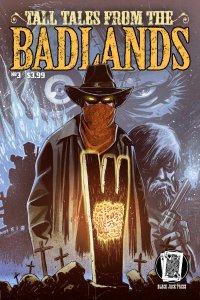 haven’t picked up their copies yet, what’s the basic concept?
haven’t picked up their copies yet, what’s the basic concept?
A: “Tall Tales from the Badlands” is a Western comic book anthology with stories that range from more conventional type Western vignettes to “Weird West” thrillers, or stories with a “Twilight Zone” or “Tales from the Crypt” type twist. The only requirements I have are that the stories be entertaining and genuinely be Westerns, not something dressed up as a Western. Natural justice. Self reliance. The conflict between man and the wild. Codes of honor and the New Frontier. That’s our stock and trade.
Q: Ok, sell it to me. Why should I slap down my hard earned money for this?
A: Because it’s good. Ha! At the risk of sounding like a pompous windbag, you should pick “Tall Tales” up because these are great stories, with nuanced characters, that are all beautifully rendered by some amazing artists. The themes are timeless. Friendship. Loyalty. Individuality. Justice. Courage. In their own way, everyone of these stories is a morality play, which is what a good Western should be. The stories entertain and say something about the human condition. If you don’t come for the prose though (which would be a mistake when you have stories from Mark Wheaton, Robert Napton and Eisner nominee Matt Dembicki), come for the art. We’ve been blessed to be able to partner up with some incredible artists. Folks like Giannis Milonogiannis (Image Comics’ “Prophet”), Jose Holder (“Deceivers” from Boom! Studios and “Kiss Kids” from IDW), Jerry DeCaire (Marvel, Moonstone), Borja “Borch” Pena, Carlos Trigo…the list goes on. These are beautiful looking books.
Q: The Western seems to have seen a bit of a resurgence of late, but a lot people are still dismissive of the genre. What are your thoughts on the Western and pop culture in the last ten years?
A: There’s a couple of ways I want to answer that. First, there’s always going to be a place for stories about the American West because people will always be fascinated with the American West. Always. Especially during periods of uncertainty, like the one we’re in right now, where the country is searching for its identity. True, Republic Pictures isn’t cranking out a dozen cowboy movies every month, but we see elements of the Western genre all over the place in pop culture. “Firefly” is an obvious example from last decade or so. “Firefly” wasn’t science-fiction, it was a Western with space opera elements. I’d go so far as to say that “The Walking Dead” (the most popular show in cable TV history) has a lot more in common with the Western — with respect to genre conventions — than it does with horror. A lot more.
I hear it a lot. “Westerns don’t sell” or “Westerns aren’t popular.” The thing is though, when you get a studio or a network with the stones to do a Western — and do it well — people flock to it. “Hell on Wheels” was just renewed for a fourth season. “Deadwood” was universally hailed by fans and critics. It made every television critics’ top five list for the years it aired. “Justified” and “Longmire” are other recent examples. In the theaters, “No Country for Old Men” and “True Grit” were both nominated for Best Picture, as was “Django Unchained,” all of which performed commercially as well. The problem is that despite all the “True Grits,” “Djangos” and “Hell on Wheels” it just takes one “Lone Ranger” before the naysayers jump up out of their seats and scream, “See! See! I told you that Westerns don’t sell. I told you.” Yeah, poorly conceived special-effects set pieces masquerading as Westerns don’t sell well. Westerns are doing just fine.
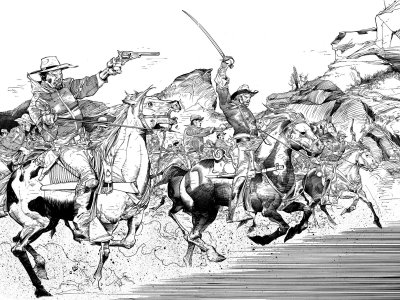 The decision to write and publish Western comics was never based on what I thought would sell the most copies or appeal to the most people. I recognize that the shelves aren’t overflowing with Western comics and Hollywood isn’t cranking out Westerns by the dozens anymore, but I’ve loved Westerns for as long as I can remember, and that’s the primary genre I chose to work in. In a lot of respects, I write the type of stories I would like to read if I weren’t writing them. I’ll be the first to admit (actually, my wife will be the first to tell you) that I’m a crappy business man. Between the Big Two, there’s really only “Jonah Hex” and that’s it. That said, I refuse to just accept what the Big Two are doing (or, more to the point, not doing) as being illustrative of the tastes of comic book readers on the whole — and more importantly, the tastes of people who aren’t reading comic books…yet. There are plenty of fans of good Westerns out there. The challenge is connecting with them.
The decision to write and publish Western comics was never based on what I thought would sell the most copies or appeal to the most people. I recognize that the shelves aren’t overflowing with Western comics and Hollywood isn’t cranking out Westerns by the dozens anymore, but I’ve loved Westerns for as long as I can remember, and that’s the primary genre I chose to work in. In a lot of respects, I write the type of stories I would like to read if I weren’t writing them. I’ll be the first to admit (actually, my wife will be the first to tell you) that I’m a crappy business man. Between the Big Two, there’s really only “Jonah Hex” and that’s it. That said, I refuse to just accept what the Big Two are doing (or, more to the point, not doing) as being illustrative of the tastes of comic book readers on the whole — and more importantly, the tastes of people who aren’t reading comic books…yet. There are plenty of fans of good Westerns out there. The challenge is connecting with them.
Q: How did “Tall Tales from the Badlands” come about?
“Tall Tales from the Badlands” is actually the by-product of a separate project. At the time I was reading a lot of comics, but wasn’t seeing a lot on the stands in the genres that I wanted to read about the most, namely westerns and war stories. I decided that I could just sit there and complain or I could do something. So I started brainstorming and researching ideas. The first idea I started serious work on was a fictionalized account of the last battle of the American Civil War (in Brownsville, Texas), fought over a month after Lee surrendered the Army of Northern Virginia to Grant. Not only did the battle involve white Union and Confederate forces, it also involved African American Union soldiers, Apache volunteers and Mexican volunteers (who fought on the side of the Confederates) — the basic racial and cultural make-up of what would become the mythical American West. The war was over. They all knew it, and the histories on the battle are all over the place as to why the battle was even fought. A Western war story. This was exactly what I was looking for. So I took that kernel and ran with it. I wrote a script. Then rewrote it. Then rewrote it again. Then decided I needed an Editor, so I enlisted the help of my friend Dave Davis, who was editing the comic column on Chud.com at the time (among many other things).
Dave shares my fascination with Westerns, and while we were doing our weekly editorial calls on “The Mother Lode” we would talk about other ideas and stories we wanted to tell. I knew that “The Mother Lode” was going to be a long way off given the artist’s (Mario Guevara) busy schedule, and I was eager to get some of the other stories in my head out of my head, so I started spitballing other projects with Dave. “Tall Tales from the Badlands” was one of them.
Q: What about influences? What inspires the stories in these volumes?
A: I’ll be honest, I find inspiration everywhere. Books, film, television, obviously, but story ideas come to me by just leaving the house. “Easy Livin’” from issue one was born out of watching a woman on the bus absolutely freak out about not being able to get an internet connection on her phone. She actually said (almost screamed), “How the fuck am I supposed to survive without internet on my iPhone!” I thought to myself, what would Jedediah Smith, or Lewis and Clark, think if they could see us now?
The films of John Ford and Sam Peckinpah are an immense influence on me, but John LeCarre, Graham Greene and Jim Thompson are just as much of an influence, even on my Westerns. John Milius (screenwriter of “Apocalypse Now,” writer/director of “The Wind and the Lion,” “Conan the Barbarian” and “Red Dawn”) is a HUGE influence on me.
If you’re writing genre fiction and you can’t acknowledge the profound influence of Ray Bradbury and Rod Serling, you’re not being honest; “The Twilight Zone” is a graduate level course on how to write meaningful short stories with complex characters. Robert E. Howard and H.P. Lovecraft are two other very powerful influences. Hell, Charles Addams and Ed Gorey…the list goes on.
Comic book influences are just too many to list, but right now Mike Mignola, Brian Azzarello, Ed Brubaker, Scott Snyder, Greg Rucka and Matt Fraction top the list. I like the folks that constantly surprise you. Who thought Iron Fist was a rich and textured character until Brubaker and Fraction got ahold of him?
Q: Where can folks get their hands on a copy of “Tall Tales”?
A: “Tall Tales from the Badlands” is available in print through Indy Planet, and digitally through DriveThru Comics, Graphicly, My Digital Comics and Wowio. We hope to be up on Comixology soon as well. Now that I’m on the west coast, I plan on attending some Cons as an Exhibitor. Start pushing the books that way as well. In fact, I just recently signed up to be an Exhibitor at the first annual East Bay (San Francisco Area) Comic-Con in February. Should be interesting.
Q: What are your plans and hopes for “Tall Tales from the Badlands”?
A: More. My intent is to keep “Tall Tales from the Badlands” a mainstay of Black Jack Press, and release a new volume about every 18 months or so. We’re in the planning stages for issue four right now. Despite all the other projects we have in the works, “Tall Tales” will always have a special place in my heart. I’ll always be working on another volume.
Q: Any other pokers in the fire? What else can we expect from Black Jack Press in the future?
A: The next year and a half are going to be insane. Aside from issue four of “Tall Tales,” we also have a Viking anthology in the works, with a very impressive crew of writers onboard. Our first mini-series, “The Mother Lode” (the aforementioned American Civil War era Western) should also be complete in the near future. Artist Mario Guevara’s (Dark Horse Comic’s “Solomon Kane,” and Dynamite Comics “The Lone Ranger and Tonto”) pages are insane. The next year should also see the release of “Ruprecht,” an all-ages comic I’m doing with artist Ben Passmore. Kind of a spooky but playful “Dennis the Menace” meets “The Addams Family” series of one-page strips I wanted to do for my kids.
Further down the road, we’ll have “The River of Blood,” a Vikings versus Russian vampires “love letter” to Robert E. Howard and Mike Mignola, with artist Carlos Trigo, and “The Forest,” about the Roman Army’s defeat in Germania, with Borja “Borch” Pena. Those are longer term projects though.
The best way to stay up to date on all the great stuff we have coming is to check in with us from time to time on our Facebook page.
A: Anything else before we sign off?
Q: Well it’s Thanksgiving as I type this, so it seems appropriate to give thanks to all the folks involved in “Tall Tales.” All the great artists and writers that I’ve had the pleasure to work with. For the most part, we’re like a little family now, and I find myself working with the same folks again and again on various projects. Very much on purpose. “Tall Tales” is a team effort and I’m blessed to have such talented and thoughtful partners. And while I’m at it, thank you Adam for arranging this interview! It means a lot to me.
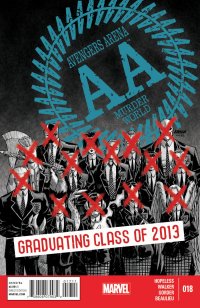 Avengers Arena #18 (Marvel, $2.99)
Avengers Arena #18 (Marvel, $2.99)
by Graig Kent
About 10 months back I reviewed Avengers Arena #3 alongside two other murder-elimination tournament books, Deathmatch from Boom Studios and Threshold from DC Comics.
I loved Deathmatch from the onset and my affection for it has not wavered as I anticipate its final issue (review TK), while Threshold I gave up on after the third issue (it was cancelled by issue 8). Avengers Arena I was probably harshest on but I stuck with it despite my initial assessment that it was both ripping off Battle Royale and cashing in on the popularity of the Hunger Games.
The series actually built something out of itself, it built a cast of characters whose sole purpose, seemingly, was to die and made you care about them as more than just cannon fodder. Of course, it was the most difficult to see this in the early goings, when we don’t know many of these personalities and they’ve been thrust into a confined space from which they cannot escape, in a situation which they have very little control and then are asked to kill one another. The genius is they’re all in-training, if not fully-trained heroes. What will it take to push them to the brink where only one is left standing.
Early on it looked like it was going to be a one-death-per-issue engagement, but thankfully Dennis Hopeless didn’t stick with that. Borrowing form Lost‘s storytelling structure, each issue tended to focus on one specific character in flashback while looking around at the larger cast in the now. This allowed the surviving characters to develop a rapport with one another, while the flashbacks began to fill in the background details on these characters motivations and their psyches. Also like Lost, every time a character received a flashback, you wondered “is this the end for them?”
Of course, this was still a dead teenager comic, but heading into the final issue only five of the kids were actually dead. The reputation of the book, as well as Hopeless’ rather shrewd craftsmanship, made it seem like more characters were being killed or dying or already dead than actually were by this point. A crafty bit of sleight of hand. If you had a favourite character already heading into Avengers Arena, like Niko from the Runaways, Mettle from Avengers Academy or even Darkhawk, then it was a very intense roller coaster ride. Even if you didn’t have a favourite character stepping into the book, you no doubt came out with one (though they may not have come out of it themselves). Hopeless, with great economy, built an excellent cast here, and managed to invest the reader in almost every one of them. And while Arcade may have been the villain that brought them into the situation, he wasn’t quite the only villain of the piece in the end.
There’s a lot happening in this final issue, and Hopeless concludes the series in a satisfying fashion, though depending on if the character you’re rooting for makes it out alive, your opinion may vary. At the same time, while we get an untrustworthy list of who’s dead on the recap page each issue, there’s no such page to close things out, meaning that even some apparent deaths may not be everything they seem.
The whole purpose of this series is really the emotional impact these events have on the characters involved, extreme teen drama if you will. The series ends leaving that ultimate impact a very open question. Thankfully Hopeless, and the extraordinarily talented Kev Walker (who illustrated the majority of the series), will be returning with some of the cast in a follow up series Avengers Undercover.
Avengers Arena surprisingly became one of my favourite reads, and I’m sad to see it end. I would recommend it to anyone who likes this sort of thing, but those easily angered and emotionally attached to fictional characters might wish to tread lightly.
Rating: 




Out of a Possible 5 Stars
Black Science #1 ($3.50 print/$2.99 digital, Image)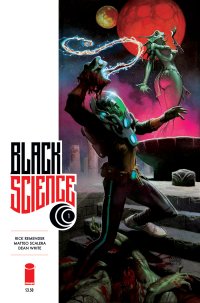
by D.S. Randlett (@dsrandlett)
Rick Remender’s star rose while I wasn’t reading comics. Friends of mine who stayed in the know during my “dark years” keep nudging me over to his work, but until today I haven’t bothered to take the plunge. More out of laziness than anything. The covers that typically adorn Remender’s creator-owned work tends to catch my attention: he’s attracted to a scifi pastiche with an emphasis on the weird. As am I. But then, media along those lines very often disappoints with an emphasis on something that more resembles collage than actual narrative. Protagonists in spacesuits from the fifties run away or dangle from cliffs while trying to avoid the snapping carnivorous maws of some Lovecraftian horror. That’s just off the top of my head, but you’ve read those comics, seen those movies and shows. The ones that truck in a certain aesthetic without giving a thought to the things that make narrative stick, when a lot of the old scifi that this pseudogenre is aping concerns itself very deeply with theme, identity, and voice.
So, I can’t speak to Remender’s past work, but Black Science’s influences are readily apparent. So the question is, does it avoid the pitfalls of the retro scifi pastiche genre that it seems to be a part of? For the most part, yes. Remender’s script can be broken in two. There’s the main action, breathless and well paced. This unfolds mostly through the art (more on that in a bit) and primary dialog. It’s a mad dash to find a suitable coolant for Black Science’s central MacGuffin device, and a pair of characters are running out of time. Of course, they’re stuck in a parallel dimension and have savage fish and frog people to contend with. This is pretty straight forward, and if this were the only element of Remender’s script, Black Science would be worth recommending for its art and not much else. Thankfully, another story unfolds parallel to the main adventure, and that’s the story of the protagonist’s inner life. This unfolds purely through narration boxes, and this is where Remender’s story separates itself from the pack. In the narration, Remender gets across the regrets of the protagonist, whose life decisions and philosophy have lead him to a profound personal tragedy. I won’t say anymore, as I think that that would rob you of one of this book’s key pleasures. Suffice it to say, Black Science has a lot more going for it than the look and feel.
It doesn’t hurt that this is one of the best looking comic books that you’re likely to see in this or any other year. Matteo Scalera and Dean White knock this out of the park, bringing a real sense of tangible life to some images that would have felt like shallow homages in the hands of lesser artists. Their art is so good that, if Remender wasn’t interested in the protagonist’s inner life and simply wrote a chase scene, Black Science would still be worth recommending. The storytelling is clear while maintaining a feeling of speed and momentum, but the real masterstroke here is just how frail and vulnerable the human characters seem in the face of the unknown.
There are some flaws, to be sure. The story starts off maybe a little too much in the deep end, but that’s part of the point here. This does come at the expense of character at certain points. A human antagonist comes out of nowhere near the end to announce his presence, for example, and we as readers have no idea what his position is exactly besides a vague vibe of “corporate show runner asshole,” and I hope that there’s more to him than that given some of this issue’s successes. Still, the adventure is just beginning, and this is a very strong start. Pick it up to hang pages on your wall if nothing else.
Rating: 




Out of a Possible 5 Stars
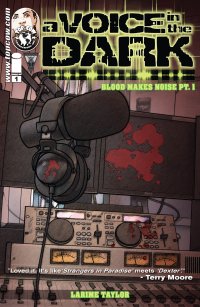 A Voice in the Dark: Blood Makes Noise Pt 1 (Top Cow/Image, $3.99)
A Voice in the Dark: Blood Makes Noise Pt 1 (Top Cow/Image, $3.99)
By Jeb D.
In a way, the real hook of this fantastic first issue is in the backmatter, and we’ll get to that in a bit.
Writer/artist Larime Taylor makes brilliant use of a grayscale world in the first chapter of the story of Zoey Aarons, a mixed-race young woman whose working-class parents are delivering her to her first day of school at a liberal-arts college in California. The setting is as mundane as you could ask for, but with an eye for the convincing detail; and the largely female cast is composed of realistically-shaped bodies and varied ethnicities. Taylor’s art occasionally suggests the starkness of Los Bros Hernandez or Terry Moore, but without Moore’s gift for facial expression: though all the characters in Voice in the Dark are well-realized and distinctive, they’re defined not by facial reactions, but through easy, naturalistic dialog, that captures the hesitancy of that transitional period in a young person’s life, as they take their first steps out of the nest… and by Zoey’s dark, disturbing interior monolog, that startles us immediately with the book’s first line:
“Dear Diary: It’s been 72 days since I killed someone.”
In fact, Zoey’s inner monolog is, often as not, a back-and-forth dialog with her darkest inner self, as she lays out for the reader the backstory behind her (as-yet unsolved) crime, and the thorny familial relationships that are going to run headlong into her impulse to kill again. She hopes that the call-in show that she begins hosting at the college radio station will provide an outlet for her darker side, but she quickly finds, unsurprisingly, that two-way communication with the outside world may make her a magnet for those just as disturbed as she is.
I’ve never seen Dexter, so I can’t truly comment on the fact that several writers (and the front-cover blurb from Terry Moore himself) have compared A Voice in the Dark to it, but apart from the notion of using a (potential, in this case, at least so far) serial killer as the story’s protagonist, I’d be surprised if Dexter ever even tried to bring such a strong portrayal to a cast of mostly non-white, ordinary-looking and real-seeming people.
Oh, and the real hook? In the text piece at the end of the book, we get Larime Taylor’s story, along with a photograph: the writer and artist of this admirably diverse comic is a white dude with an aging-hippie ponytail, who has a disability that robs him of the use of his arms, and forces him to do all his work on computer, with a Wacom tablet, by means of a stylus held between his teeth. This first issue would be a helluva start for a fully-abled woman of color; for a physically-challenged white male, it’s a noteworthy achievement. More to the point, though, it’s a gripping introductory chapter (as well as a generous 40 pages) that would have me eager for more, even if I knew nothing of the author’s personal story.
Rating: 




Out of a Possible 5 Stars